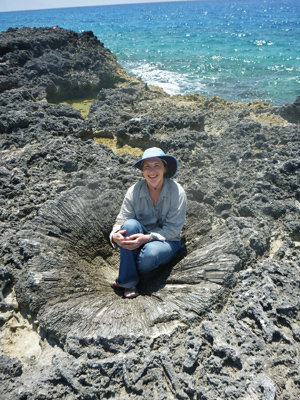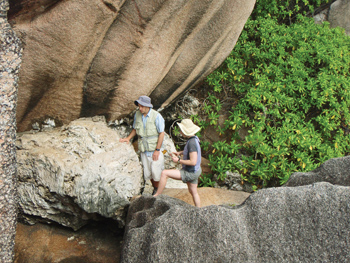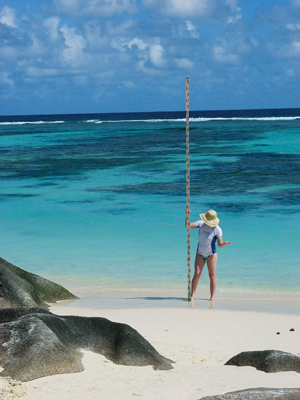The Rise of the Oceans
By Eric Goldscheider
Photos courtesy Andrea Dutton ’95
[Climate change] Thanks to records derived from ice core samples, geoscientists can identify, with considerable accuracy, the average temperatures at the Earth’s poles over the past 400,000 years. We know less about how those temperatures correlate to the rise and fall of global sea level. That is where researchers such as Andrea Dutton ’95 come in.

Dutton sits in a fossil coral head in the Bahamas.
An assistant professor of geological sciences at the University of Florida, Dutton is interested in where the oceans met the land 125,000 years ago, during the last period between ice ages. Polar temperatures at that time were slightly warmer than they are now but slightly cooler than what scientists predict for the near future, making that era “a very good analog for thinking about what’s going to happen” to our oceans, says Dutton.
This summer Dutton headed to Seychelles, an island country in the Indian Ocean, near the equator, to probe dead coral formations on land that was once under water. Using a dating method that looks at the decay of uranium and thorium isotopes over time, Dutton can pinpoint the age of coral at various elevations to within 500 years. Because coral lives just below the surface of the water, this dating method can tell her where sea level was at a particular time in history.

Her work adds to data suggesting that, if ice sheets keep melting as polar temperatures tick upward, the average global sea level will rise by 20 to 30 feet. An unanswered question is how quickly that will happen.
“That is a huge number,” says Dutton of the predicted sea level rise. “We are only talking about a few degrees warmer at the poles than 125,000 ago, and projections from climate models are that we will surpass those temperatures in the next few decades.”
Last year Dutton and a colleague, geoscientist Kurt Lambeck, published a paper in Science, “Ice Volume and Sea Level During the Last Interglacial,” that raised the profile of her work in the popular press.
Hurricane Sandy also drew attention to her research, because it prompted concern about how rising sea level might affect cities as climate change speeds up.
Scientific consensus is forming around the idea that “coastlines are going to retreat significantly,” says Dutton. However, she says, the effects of melting polar ice sheets will vary around the world, because of such things as local topography and ocean currents. The bad news for much of the Atlantic coast of the United States is that the land is sinking, which means the region may see a rate of sea-level rise that is higher than the global average. A factor that contributes to this sinking is the lingering settling effects from when ice sheets receded 18,000 ago—“a blink of an eye,” she says, in geologic time.

Places like Seychelles are fruitful for Dutton’s research because they are far from the expanding and contracting ice sheets in the northern hemisphere that influence the volume of the oceans over time. “Sea level [in Seychelles],” she says, “is very close to the global average signal we want to reconstruct.”
Goldscheider is an Amherst-based freelance writer.